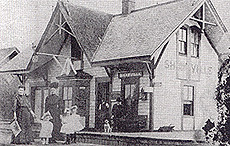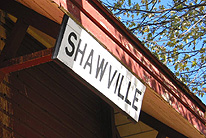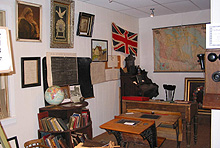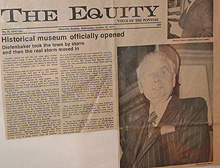 The Pontiac Pacific Junction Railway (PPJ), constructed along the Ottawa River from Aylmer to Waltham in the 1880s, was a huge boon to the Pontiac. The towns that were situated directly along the route benefited the most -- towns like Waltham, Fort Coulonge, and Shawville. Today, the Pontiac Pacific Junction Railway is only a memory in the region. Taken over by Canadian Pacific in 1902, passenger service on the line was discontinued in 1959. Freight service followed suit in the 1980s, after which the rails were permanently dismantled.
The Pontiac Pacific Junction Railway (PPJ), constructed along the Ottawa River from Aylmer to Waltham in the 1880s, was a huge boon to the Pontiac. The towns that were situated directly along the route benefited the most -- towns like Waltham, Fort Coulonge, and Shawville. Today, the Pontiac Pacific Junction Railway is only a memory in the region. Taken over by Canadian Pacific in 1902, passenger service on the line was discontinued in 1959. Freight service followed suit in the 1980s, after which the rails were permanently dismantled.
PPJ CYCLOPARK
A few years ago, the former rail bed was converted into a linear park or bicycle trail. Called the PPJ Cyclopark, it extends 71 km from Wyman, on the eastern border of Pontiac County, to Waltham, near L’Isle aux Allumettes. An additional 20 km of trail traverse L’Isle aux Allumettes.

SHAWVILLE STATION
One of the many historical sites that may be seen along the former rail line is the old Shawville train station. The station dates to the arrival of the PPJ in Shawville in the winter of 1886. The event was the occasion for one of the largest celebrations in the village’s history:“The grand banquet that night at Hynes’ Hall was talked about decades later. The coming of the steel rails was expected to bring Shawville and indeed the entire county an era of prosperity. For the most part, those expectations were realized. Farm produce by the thousands of tons was shipped [from Shawville station]… People and freight came in and out of town on a daily basis. The town grew and prospered… The march of time, however, continued unabated and the age of rail transportation slowly died in Shawville.”(1)
PONTIAC MUSEUM
The old Shawville station has changed a great deal from the way it looked in its heyday. The gable over the ticket booth has been removed, the building has been enlarged, and, of course, passengers no longer wait for the train on the platform. Since the 1970s, the station has been home to the Pontiac Museum. Run by the volunteers of the local historical society, the museum is open on weekends in the summer and for special events like the county fair.

Inside is an assortment of relics from around the county: antique agricultural machines; domestic appliances; period clothing; and other curiosities. In one corner, a small schoolroom is arranged with appropriate desks and blackboard. On the other side of the room is a re-created general store. In yet another corner hangs the yellowing front page of an old issue of The Equity, the local newspaper. It shows a photo of a smiling John Diefenbaker, who officially opened the museum back in 1976.

Looking around, it doesn’t appear that much has changed since “Dief” cut the inaugural ribbon thirty years ago. The museum, however, is still worth a visit, if only to see this remnant of a once thriving railway, a railway that played so important a role in the history of the Pontiac.
End Notes:
1. Sandra Carson et al., Shawville Historical Walking Tour, 1995.